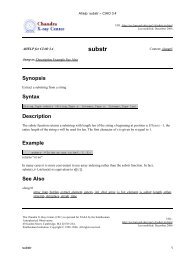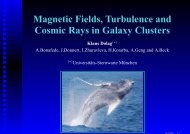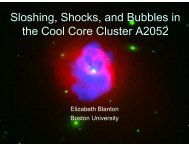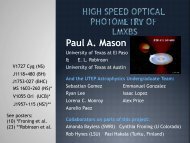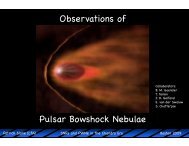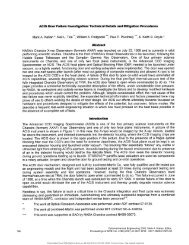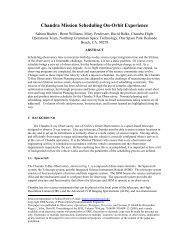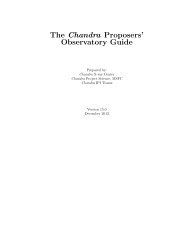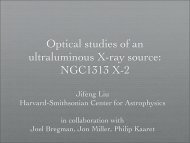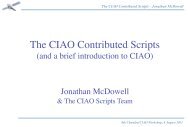PDF Version - Chandra X-Ray Observatory (CXC)
PDF Version - Chandra X-Ray Observatory (CXC)
PDF Version - Chandra X-Ray Observatory (CXC)
Create successful ePaper yourself
Turn your PDF publications into a flip-book with our unique Google optimized e-Paper software.
Spring, 2012<br />
CIAO 4.4<br />
Improved tools, a new graphical user interface for<br />
plotting and advanced Sherpa functionality<br />
Antonella Fruscione, for the CIAO Team<br />
The newest versions of the <strong>Chandra</strong> Interactive Analysis<br />
of Observations software and the <strong>Chandra</strong> Calibration<br />
Database (<strong>Version</strong> 4.4 of CIAO and CALDB 4.4.7), were<br />
released in December 2011 (http://cxc.harvard.edu/ciao).<br />
These include numerous enhancements and bug fixes with<br />
respect to previous CIAO versions, all listed in detail in the<br />
software release notes. We will describe here some of the<br />
most notable changes and improvements.<br />
CIAO Tools<br />
• acis_find_afterglow is a new tool which improves<br />
over previous algorithms by identifying shorter afterglows<br />
as well as ones with larger gaps between the events comprising<br />
them.<br />
A cosmic-ray “afterglow” is produced when a large<br />
amount of charge is produced by interaction with a charged<br />
particle. Most of the charge is clocked off of the CCD in a<br />
single frame. However, a small amount can be captured in<br />
charge traps, which release the charge relatively slowly. As a<br />
result, a sequence of events can appear in a single pixel over<br />
a few to even a few dozen frames, and the events do not<br />
necessarily occur in consecutive frames; there can be gaps<br />
of several frames with no events for the pixel. In general,<br />
the amount of charge released per frame declines with time.<br />
However, the trend is not monotonic, especially near the<br />
end of an afterglow. More details on afterglows, afterglowidentification<br />
algorithms and how to display the afterglow<br />
events can be found in the “Why Topic” “Cosmic-<strong>Ray</strong> Afterglows”<br />
at http://cxc.harvard.edu/ciao/why/afterglow.html<br />
The tool acis_find_afterglow searches for<br />
afterglows using a short, sliding time window. If there is<br />
a statistically significant excess of events compared to the<br />
expected number of background events, then the excess is<br />
identified as an afterglow unless the excess seems to be associated<br />
with a source that is periodically dithered across the<br />
pixel. The algorithm used to estimate the nominal number<br />
of background events is designed to avoid contamination<br />
by bright sources. Essentially all of the afterglows that have<br />
four or more events are identified by acis_find_afterglow.<br />
The tool acis_find_afterglow also searches<br />
for hot pixels, using an algorithm that is similar to the afterglow-identification<br />
algorithm except that the time window<br />
used is the entire duration of an observation. Events<br />
19<br />
associated with afterglows are ignored during the search for<br />
hot pixels. The tool acis_find_afterglow supersedes<br />
the tools acis_classify_hotpix, acis_detect_<br />
afterglow, acis_find_hotpix, and acis_run_<br />
hotpix for all analyses.<br />
• The Mexican-Hat Wavelet source detection tool wavdetect<br />
now takes an observation-specific PSF map file<br />
(created for example with mkpsfmap) instead of using<br />
<strong>Chandra</strong> PSF table data from the CALDB. Data from other<br />
missions (e.g. ROSAT, XMM-Newton) can also be supported<br />
by providing a psfmap (see “ahelp wavdetect”<br />
for more details).<br />
• The addrsp tool adds together multiple imaging ARFs<br />
(auxiliary response files) and RMFs (response matrix files)<br />
to create a pair of merged ARF and RMF files weighted by<br />
ARFs and exposure. The tool may be run with just ARF files<br />
as input to create a merged ARF weighted by exposures.<br />
The addresp tool may now be used to combine grating<br />
ARFs, creating the same output as the dmarfadd tool. We<br />
have also added support for combining the ARF and RMF<br />
into an RSP file instead of making two separate files.<br />
• The asphist tool bins the aspect solution of an observation<br />
into a 3D histogram of duration vs x and y pointing<br />
offset and roll offset. The value in each bin is the time the<br />
pointing was within that offset bin during the observation,<br />
as modified by the good-time interval (GTI) and deadtime-correction<br />
factor (DTF). The updated algorithm uses<br />
the full tangent plane offset computations and the correct<br />
angle between pointing and North. Both of these changes<br />
improve the accuracy of data reprojected to different tangent<br />
points and/or combined from multi-obi observations<br />
with significantly different pointings.<br />
CIAO Scripts<br />
The CIAO contributed scripts package (http://cxc.<br />
harvard.edu/ciao/download/scripts/) is considered a required<br />
part of the software installation and contains analysis<br />
scripts and modules written by scientists at the <strong>CXC</strong>.<br />
The contributed scripts and modules automate repetitive<br />
tasks and extend the functionality of the CIAO software<br />
package by filling specific analysis needs. The package is<br />
updated about once a month and concurrently with major<br />
CIAO releases. For CIAO 4.4. all scripts were retested<br />
to ensure a smooth running within the new system. Some<br />
scripts, including specifically <strong>Chandra</strong>_repro, combine_spectra<br />
and specextract, were upgraded to<br />
use the new tools and features of CIAO 4.4. For example,<br />
<strong>Chandra</strong>_repro is using the new tool acis_find_<br />
afterglow in place of acis_run_hotpix to identify



